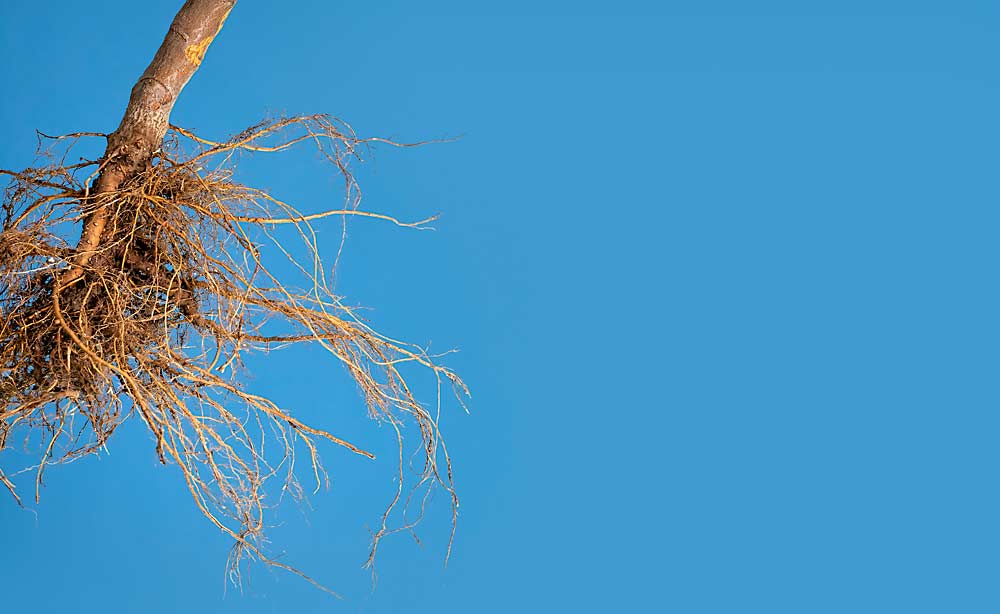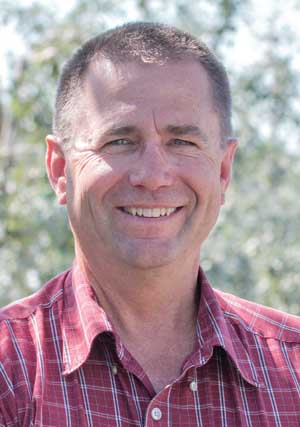
Apple growers today have more rootstocks to choose from and more opportunities to select roots that will meet their orchard’s specific needs, but all the new options make deciding what to plant increasingly complex and confusing.
“When I put together rootstock plans for a site, sometimes I feel like I am playing the lottery,” said Mario Martinez, an orchard manager for Washington Fruit and Produce Co., during a panel on rootstock selection at the Washington State Tree Fruit Association’s annual meeting in December. “You never know what you are going to get.”
Fellow panelist Dave Allan, of Allan Bros., agreed. Researchers always say that selecting the right rootstock is critical, but they never actually tell you exactly how to do that, he joked.
“I’ve been doing this for 50 years and I still don’t know what the right rootstock is,” he said. “When we first started, we were concerned about size and productivity. Now, we are looking at resistance to replant, fire blight, and susceptibility to bitter pit.”
A resource to help growers wade through those factors and make better rootstock selections is critical to increasing orchard profitability — and it’s in the works as part of a broad effort to develop better rootstocks and learn how best to use them. Known as the Root2Fruit project, it’s being funded by the U.S. Department of Agriculture.
The 14 rootstocks now released from the Geneva program, all precocious and fire blight resistant, represent an unprecedented opportunity as growers replant with new cultivars to meet changing market demands, said Cornell University horticulturist Terence Robinson.
“We’re trying to produce designer rootstocks so that each grower could, with help, try to identify the rootstock that will grow the tree well enough for their variety, their soil, their climate, so that it can fill the space by the end of the second year,” he said.
That help will come in the form of an online tool he plans to develop so that growers can input region, soil type, cultivar and other factors for a recommendation. “I hope that over the course of the next three years of the Root2Fruit project, this will be one of the main deliverables for growers,” he said.
Root2Fruit research
The decision-aid tool Robinson envisions will have to be a living program, continually updated as researchers learn more about rootstock performance under certain conditions, and as breeders continue to release both new rootstocks and new cultivars.
The Root2Fruit project focuses on how rootstocks contribute to tree nutrition and fruit quality, respond to soil stresses such as replant disease and pH, and increase orchard profitability. As participating researchers make significant findings, they feed those results back to Geneva rootstock breeder Gennaro Fazio, so he can incorporate the insights into his program.
By comparing the rootstock phenotypes that seem to tolerate saline soils well, for example, with those that do not, he can find the regions of DNA that seem to influence salt tolerance and create a tool, known as a marker, to find the same important genetic code in new seedlings.
So far, Fazio has markers for dwarfing, woolly apple aphid resistance and strong potassium uptake. He’s now working to identify genes that control what rootstocks sweat into the soil around them, thereby attracting beneficial microbes and symbiotic fungi. He tests for fire blight and phytophthora resistance the old-fashioned way, however — inoculating seedlings and discarding those that die — because it’s quick and easy.
The DNA markers allow Fazio to eliminate seedlings that lack desired traits without waiting to grow the trees, but breeding is still a numbers game, and if he applied markers for every trait of interest all at once, he might be left with just a handful of seedlings out of his initial pool of about 10,000 produced each year. That’s not enough to have good odds for finding successful candidates, he said.
“It’s going to be difficult to bring everything into one package,” he said. “By design, rootstocks are going to be different. That’s the point.”
A new tool
As much as growers and nurseries might wish for one perfect rootstock, the complexity of the industry has moved beyond that possibility.
“If you just put in a jack-of-all-trades rootstock, it’s not going to make the orchard sing,” Fazio said. “As scion breeders come up with new varieties, there is going to be a rootstock that makes that scion really good.”
But the shift in the direction of designer rootstocks is daunting.

“If you look where the industry came from, prior to the Geneva stuff coming out, we had five rootstocks that were the backbone of the industry, and the differences were not huge,” said Dale Goldy, president of Gold Crown Nursery and a member of the Root2Fruit stakeholder advisory committee. Now, with new rootstocks and all the new varieties coming into the market, “it gets to be a pretty complex problem.”
“The amount of information they are collecting out of all these trials is going to add another whole dimension to planning a planting project,” Goldy said.
Another complexity involves developing a tool that can draw on findings from those rootstock research trials, now looking at everything from tree growth and yields to fruit quality and storability. How exactly it will work and what organization will host and maintain it remains a work in progress.
Goldy said that such a tool sounds very valuable but added that growers would likely still want to test out the rootstocks for themselves with whatever scion they are planning to grow.
“I can see a tool where you take a soil sample and you plug in that information — soil type, pH, NPK levels, replant — and ultimately, it gives you a suggestion,” Goldy said. “It’s not going to tell the grower exactly what to do, it just increases the probability that he has a successful trial plot.”
The second part of making designer rootstocks a reality for growers is ensuring the right rootstocks are available to them, Robinson said.
“Say a grower gets these rootstock recommendations, but their nursery doesn’t have that. So, they say ‘I will just take what they have,’” he said. “But that has economic consequences.”
Planting low-vigor scions such as Honeycrisp or SnapDragon on weak Budagovsky 9 roots can mean years of lost productivity waiting for the trees to fill their space, Robinson said. B.9 remains the preference for many growers in New York, but Robinson and Fazio think that once growers plant comparison trials with some of the newer rootstocks, they’ll make a switch.
“Initially, there is going to be a learning curve, but as these rootstocks become more available and more information comes out, I think it’s going to make the industry more productive,” Fazio said. “They are already making the industry more productive.”•
—by Kate Prengaman
Related: Cornell roots for Geneva rootstocks






Leave A Comment